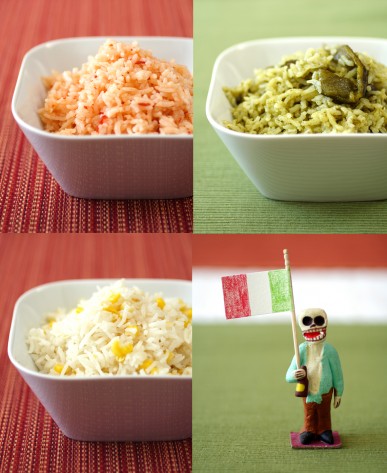Red, White, and Green: The Colors of the Mexican Flag and Table

Shown above, clockwise from the top left, are bowls of Arroz a la Mexicana, or “Mexican Rice,” which, tinged red from tomatoes, could just as well be called “red rice,” Arroz Verde, or “Green Rice,” Arroz Blanco, or “White Rice,” and the Mexican flag held by a Day of the Dead figure, who would rather not be used as a flagpole so that he could get on with the business of drinking and smoking.
When flipping through Diana Kennedy’s numerous books on Mexican cooking, anyone new to Mexican cooking will quickly notice that dishes often come in red, white, and green versions—the rice dishes above being one example, pozole, another—and that the number and uses of red and green sauces are innumerable. You also get the sense that regionalism is still very much alive and well across Mexico—this is particularly in evidence in Diana Kennedy’s latest, very large tome Oaxacca al Gusto, which is devoted to the cooking of state of the Oaxaca. Despite the rich diversity of regional cooking styles and dishes that make up the cooking of Mexico, I imagine Mexicans, perhaps more than most countrymen and women, have a strong national connection to their cuisine as the colors of their nation’s flag are to be seen, in one way or another, on their dinner table.
Besides giving me an opportunity to include my Day of the Dead figure in a photograph for the DCCC blog, and have fun with culinary color theory, I made these multi-step rice dishes to get out of my newfound rut of making plain, boiled Mexican white rice (morisqueta). In these three flavorful recipes from The Art of Mexican Cooking, the rice is fried in oil, or better yet lard or chicken fat, pilaf style, and then cooked in chicken broth with herbs, chiles, and/or vegetables added for color and flavor.
In Mexican cooking, rice dishes and pasta dishes are classified as sopa seca, which translates as “dry soup.” In Authentic Mexican, Rick Bayless stipulates that these dishes got their name because all are cooked in a broth or stock, which is then cooked until dry. (Even the pasta for the pasta dishes is boiled in cooking water flavored with vegetables and/or spices or herbs—a vegetable stock of sorts.)
In Mexico, sopa seca are generally served alone after the botana, or appetizer, and before the main course. In my kitchen, I paired these hearty rice dishes with a side of refried beans (frijoles refritos) topped with a sprinkling of cheese (queso añejo or Muenster are good options) to make a delicious, economical, and nutritious light meal. A green salad is all that could be wanted.
